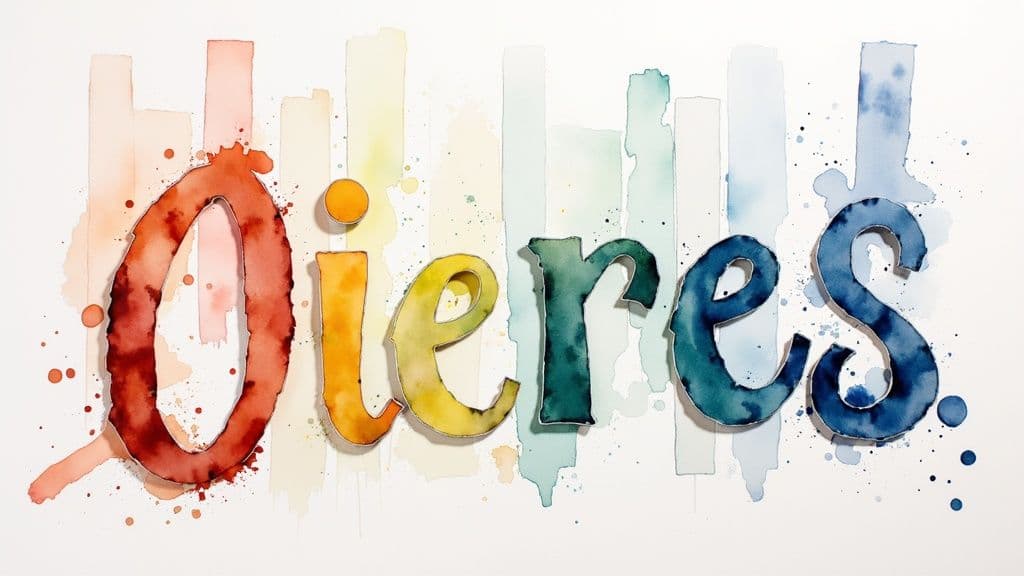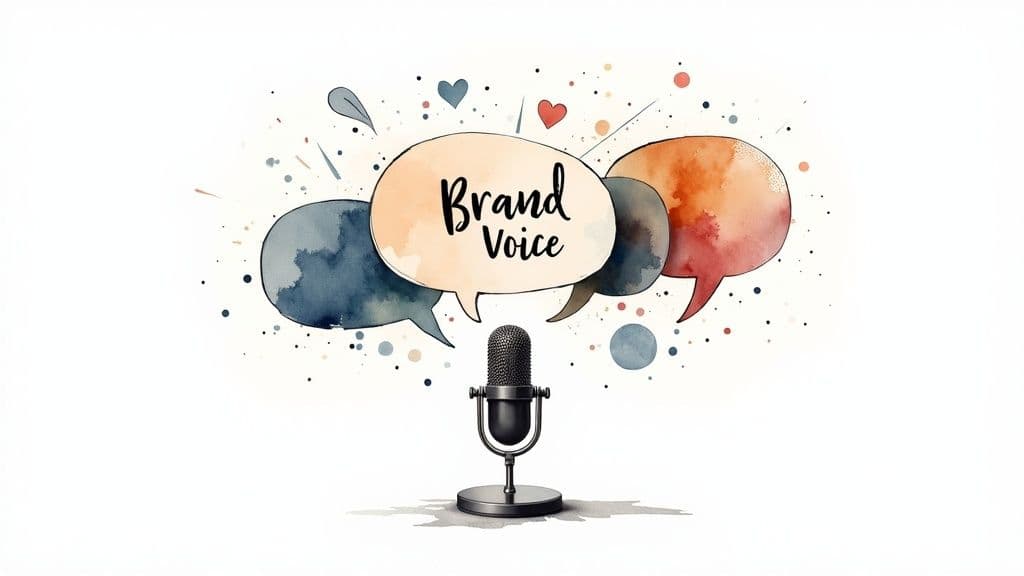
Create Your Perfect AI Body Outline Template
Learn to design, customize, and use a unique body outline template with AI. Our guide offers practical tips for artists, designers, and creators.
Learn how to create brand guidelines that build trust and consistency. Our guide offers actionable steps and real examples for a stronger brand identity.

Instastock Team
October 1, 2025 • 14 min read
Creating brand guidelines isn't just about making a rulebook for your brand’s personality. It’s about building a playbook that ensures every message, design, and interaction feels cohesive, consistent, and genuinely you. It's the process of nailing down your visual identity, your unique voice, and the ground rules for using them, so everyone on your team can represent the brand perfectly.
Let's walk through how to make that happen.

I get it. The term 'brand guidelines' can conjure up images of a stuffy, corporate document that gathers dust on a server somewhere. But what if you thought of them as your secret weapon for building real, lasting customer trust?
Think of your guidelines less as a set of rigid rules and more as a shared language that empowers your entire team. From the marketing department and the sales team right through to customer support, clear guidelines help everyone make confident decisions that strengthen your brand with every single interaction. This isn't about stifling creativity; it’s about providing a solid framework for it to shine.
Consistency is the absolute bedrock of a memorable brand. When customers encounter the same colours, messaging, and overall vibe across your website, social media, and even your packaging, it builds a powerful sense of familiarity and reinforces what your brand is all about.
This kind of alignment is non-negotiable in today's crowded markets. Research shows that 71% of UK consumers show their trust by buying more from a brand, a behaviour that’s directly tied to consistent presentation. What's more, with 52% of UK consumers actively skipping generic ads, your guidelines become the very tool that makes sure your content feels distinct and personal, every single time.
Think of your brand guidelines as the single source of truth that turns random acts of marketing into a unified, powerful brand story. They ensure that no matter who is creating the content, the result always feels like it came from you.
A well-crafted guide just makes life easier for everyone. It completely eliminates the guesswork and cuts down on needless back-and-forth.
Instead of your team debating which hex code is the right shade of blue or what tone to strike in a customer service email, they have a go-to resource. This not only speeds up workflows but also acts as a built-in quality control check.
To get the most out of your guidelines, it’s worth looking into brand asset management solutions. These platforms give you a central hub for all your approved logos, images, and documents. This makes it incredibly simple for everyone—including external agencies and freelancers—to find and use the right materials, protecting your brand's integrity along the way.

Before you even think about picking colours or fonts, you need to get to the core of what your brand is all about. This is where a little bit of soul-searching goes a long way.
Think of it as a therapy session for your brand. Seriously.
Grab a notebook, get comfortable, and try these simple exercises to get the ball rolling:
Let's start by trying to nail down your mission in a single, clear sentence. This sentence will become your north star, the filter through which you make every single decision. It’s what keeps you on track when shiny new ideas pop up.
Next, think about your vision. Fast forward five years. When you hear your brand’s name, what do you want people to associate it with? What kind of impact have you made?
"Your mission should feel like a promise you plan to keep," advises brand strategist Maria Lopez.
Your core values start to reveal themselves when you repeatedly ask "why." For instance, if you say "honesty" is a core value, ask yourself why that's so important. Keep digging until you hit a real, foundational emotional need. These insights are the very backbone of your brand guidelines.
Think about values like:
Don't just list the words, though. Each value needs a short description of what it looks like in practice. For example, "transparency" could mean sharing behind-the-scenes updates with your audience every month.
Turning these abstract ideas into a compelling story is how you connect with people on an emotional level. It’s the difference between just selling a product and building a community.
Take Ella’s bakery, which started in a garage with a simple dream of offering wholesome treats. That origin story became an anthem for local artisans and created a loyal following.
Look for similar anecdotes in your own journey that will resonate with your audience. A great way to structure this is with a classic narrative arc:
This simple framework transforms your values from words on a page into memorable tales. It also gives you a fantastic starting point for defining the tone and imagery you’ll use in your marketing.
You can learn more about how to bring these stories to life visually in our guide on visual storytelling.
Once you have your narrative locked down, every design choice and piece of copy can become a form of meaningful communication, not just decoration. This foundation is crucial for building guidelines that truly capture your brand’s essence.
Now that you've got your story, it's time to translate it into practical guidelines. Think about how this narrative will show up in everything you do—from social media posts and email campaigns to the very packaging of your products. Every touchpoint should echo a piece of your brand’s journey.
Your guidelines should include a checklist like this:
A consistent narrative makes your guidelines a living roadmap for every creative decision.
Finally, pull all of these discoveries together into a concise, one-page summary. This snapshot ensures anyone on your team—from a new hire to a freelance designer—can understand your brand’s heart and soul at a glance.
This document becomes the ultimate reference point as you build out your full brand guidelines, helping you maintain a genuine, lasting connection with your audience. With these roots firmly in place, you’re ready to create a consistent and impactful brand.

This is the fun part. It’s where all that soul-searching about your brand’s personality gets a face. A strong visual identity does so much more than just look good; it creates a consistent, memorable experience that builds real trust. Every single visual piece—from your logo to the filter on an Instagram story—needs to feel like it came from the same creative family.
Let’s get into the practical bits and pieces of your visual system. The goal is to make sure it all works seamlessly, no matter where your brand shows up.
Your logo is your brand’s most concentrated symbol, so how you use it has to be spot on. When a logo is misused, it can easily dilute your brand's power and just look unprofessional. Your brand guidelines are the rulebook for making sure that never happens.
Don't just think of it as something you slap on a document. You need to set clear, non-negotiable rules for things like:
Think of your logo usage rules not as a creative straitjacket, but as a guardrail protecting your most valuable visual asset from embarrassing and costly mistakes.
Colour is pure emotion. The right palette can instantly make people feel something, whether it’s the high-energy buzz of a tech startup or the calming reassurance of a wellness brand. A defined palette is also one of the fastest routes to brand recognition. In fact, some studies show that consistent use of a signature colour can boost brand recognition by up to 80%.
Your brand guidelines need to make your colours completely foolproof for anyone to use.
For every single colour, you absolutely have to provide the specific codes for both digital and print. That means HEX for web, RGB for screens, and CMYK for anything that gets printed. Getting these technical details right is non-negotiable if you want true consistency. Planning this out is a key part of the creative process, and using a structured design brief example from the start can help you keep these requirements organised.
To make sure you've covered all your bases, here's a quick checklist for the essential visual elements your brand guidelines need. This will help you keep everything consistent.
| Visual Element | What It Defines | Key Decisions to Make |
|---|---|---|
| Logo | The primary symbol of your brand | Variations (full, icon), clear space rules, minimum size, and examples of incorrect use |
| Colour | The emotional tone and recognition factor | Primary, secondary, and neutral palettes with HEX, RGB, and CMYK codes for each |
| Typography | The voice and readability of your written content | Primary (headlines), secondary (body text), and optional accent fonts; size & weight |
| Imagery | The overall aesthetic and feeling of your brand's visuals | Photography style (e.g., candid vs. staged), illustration style, and any filters/overlays |
This table acts as your at-a-glance reference to ensure every visual touchpoint is perfectly aligned with your brand.
Typography is a huge part of your visual identity, and it subtly says a lot about your brand's message. The fonts you choose have a personality. Are you modern and clean, or are you more traditional and elegant? Your guidelines should create a clear typographic hierarchy so there's no guesswork.
You'll usually need two to three font families to get the job done:
Your guidelines should also spell out which font weights to use (e.g., Bold for H2 headings, Regular for paragraphs) and suggest sizes. If you really want to get this right, exploring resources on mastering typography can give you some fantastic insights.
Last but not least, your photography and illustration style is the glue that holds everything together. Every image you post should feel distinctly yours. You need to land on an aesthetic that feels completely in sync with your brand’s core message.
Ask yourself a few key questions:
The best way to communicate this is visually. Include a small gallery in your guidelines with "on-brand" and "off-brand" examples side-by-side. Seeing the difference is often way more powerful than just reading about it, giving your team an instant understanding of what to aim for.

Let’s be honest: how you say something matters just as much as what you’re saying. A clearly defined brand voice is what turns your company from a faceless logo into a personality people actually want to connect with. It’s time to get past vague advice like "be friendly" and really nail down a voice that is uniquely and authentically yours.
The goal here is to sound like a real person, not a corporate script. This means crafting a communication style that’s rooted in your core values and genuinely speaks to the people you want to reach, whether your style is witty and irreverent or authoritative and empathetic.
A great way to get started is to imagine your brand as a person. Seriously. If your brand walked into a room, what would they be like? How would they talk?
Once you have a sense of this personality, try creating a simple chart with a few key traits. For each one, list words you’d use and, just as crucially, words you would actively avoid. This simple exercise gives your entire team a clear and practical reference point.
Your brand voice isn't just about the words you choose; it's about the feeling you leave with your audience. It’s the consistent personality that shows up in every email, social post, and product description.
Abstract descriptions of your voice will only get you so far. The most powerful way to guide your writers and keep everyone on the same page is with concrete "Do this, not that" examples. These practical comparisons are the secret sauce to making sure everyone gets the nuances of your brand voice.
| Instead Of This (Generic) | Do This (On-Brand) |
|---|---|
| "Our new product is now available for purchase." | "Your wait is over. The moment you've been asking for is here." |
| "Please contact customer support for assistance." | "Having trouble? Our friendly support team is ready to help." |
These examples instantly translate your brand's personality into real-world writing. This becomes absolutely vital on social media, where your voice has to cut through the noise. While 72% of media experts see social media as a top priority for engagement, a staggering 52% of those same professionals also view it as the area most prone to brand damage. This just highlights how important clear voice guidelines are for protecting your reputation online. You can dig into more of these industry insights in the full 2025 report.
Finally, it’s crucial to understand the difference between voice and tone. Your core voice—your brand's fundamental personality—should never change. Your tone, however, needs to adapt to the situation and the platform you're on.
Think of it this way: you have one personality, but you probably don’t speak to your best friend in the exact same way you would in a formal business meeting.
Your brand guidelines should include clear examples for how to adapt the tone for these different contexts without losing that core identity. This is how you ensure you always sound like "you," no matter where your brand shows up.
Your brand doesn't just live on a billboard or a business card anymore. It exists out in the real world, shaped by conversations, values, and the fast-moving pace of digital life. A truly useful brand guide has to go beyond just colours and logos; it needs to be a compass for how your brand shows up on a human level.
Think about it: today's customers care deeply about a brand's impact. Research from Huddle Creative shows that a massive 62% of Gen Z shoppers prefer sustainable brands, and three-quarters of all consumers say inclusivity influences their buying decisions. These aren't just fluffy trends; they're table stakes. To build real loyalty, your guidelines need to get specific about things like inclusive language and ensuring your visuals represent a diverse world.
How your brand acts online is your brand identity for many people. Your guidelines should be a practical playbook for navigating this space, especially when you're bringing in outside help or playing with new tech.
You'll want to cover a few key areas:
This isn't about boxing your team in with rigid rules. It's about giving them a solid framework so they can act confidently and ethically online. It’s how you make sure every single digital touchpoint strengthens the brand you’re working so hard to build.
A modern guide also has to tackle the tricky business of visual content. The images you choose—whether they're shot in-house, pulled from a stock library, or even generated by AI—need careful management. They have to reflect your values and, crucially, keep you out of legal hot water.
For example, your guidelines should have a section on using stock photography so it feels authentic and on-brand, not like you just grabbed the first generic photo you saw. It’s also incredibly smart to include a clear policy on respecting intellectual property.
We actually cover this in detail in our guide on how to avoid copyright infringement. By tackling these modern challenges head-on in your guidelines, you're not just creating a document—you're building a practical tool for a respected, future-proof brand.
As you dive into creating your own brand guidelines, you're bound to run into a few tricky questions. It happens every time. Let's tackle the most common ones I hear from teams, so you can sidestep the usual hurdles and keep everyone on the same page from the get-go.
Think of this as a quick-start guide to the questions that really matter.
Honestly, clarity beats length every single time. A lean 10-page guide that covers the absolute essentials—logo usage, colour palette, and brand voice—can be perfect for a small startup. On the other hand, a sprawling global brand might need a 50+ page bible to manage everything from legal disclaimers to regional marketing nuances and detailed design templates.
I once worked with a boutique agency that started with a simple 12-page PDF. It was great. But as they expanded, they built it out into a 30-page online portal to include social media policies and specific image style guides. They grew it as they needed it, which meant the team was never overwhelmed.
| Team Size | Typical Length | Core Focus |
|---|---|---|
| Small business | 8–12 pages | Logo, colour, voice |
| Medium brand | 20–35 pages | Social media, templates, imagery |
| Global enterprise | 50+ pages | Asset library, legal, regional guidelines |
Pulling together brand guidelines is a team sport, not a solo mission for the design department. While marketing and design will naturally take the lead, you absolutely want people from sales, customer support, and even HR in the room. Why? Because they’re on the front lines, hearing directly from customers and seeing where inconsistencies pop up in the real world.
And here’s the non-negotiable part: you need leadership buy-in. When founders or senior directors champion the brand's core values, mission, and tone, everyone else falls in line so much faster. It sends a clear signal that this stuff matters.
Collaboration is the secret sauce. Getting input from across the company creates guidelines that people actually use, rather than a file that just gathers digital dust.
Your brand guide should be a living document, not a "set it and forget it" PDF. I recommend scheduling a formal review at least annually. This is your chance to revisit your brand voice, make small tweaks to the colour palette, and account for any new channels that have popped up. Of course, a major event like a full rebrand or expanding into a new market will call for a complete overhaul.
Smaller updates can, and should, happen as needed. For example:
The key is to give someone clear ownership of the document. They can track feedback, approve changes, and make sure everyone knows what's new.
The single worst thing you can do is pour time and energy into creating a beautiful document that nobody ever uses. This usually happens for one of two reasons: the rules are too vague, or they're so restrictive that they stifle all creativity. Both lead to the same outcome—people ignore them.
A much better approach is to find a balance between structure and freedom. Don't just list rules; explain why each one exists. When your team understands the thinking behind a guideline, they’re far more likely to respect it. Make the guide easy to find, simple to search, and straightforward to share. Kicking things off with a launch workshop or offering quick training sessions can make a world of difference, too.
A guideline without context is like a map without a legend: confusing and very easy to ignore.
Ready to create on-brand visuals that fit your new guidelines perfectly? Check out Instastock at https://instastock.studio and generate your first five images for free. Instastock’s AI-powered editor makes it incredibly simple to produce unique, licence-free assets in seconds.

Learn to design, customize, and use a unique body outline template with AI. Our guide offers practical tips for artists, designers, and creators.

Discover 7 standout sources for a healthy lifestyle poster. Our guide offers design insights for clinics, schools, and offices to inspire wellbeing.

Discover how to craft beautiful DIY gift cards envelopes. Our guide offers creative ideas and simple tips to make your gift feel extra special.